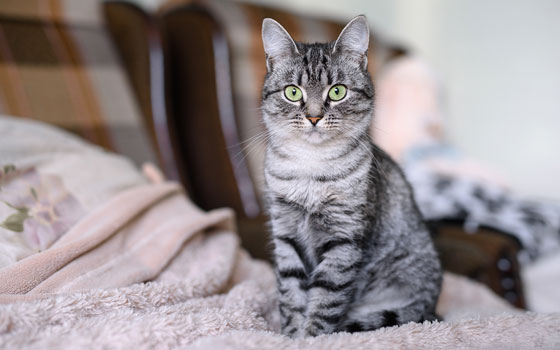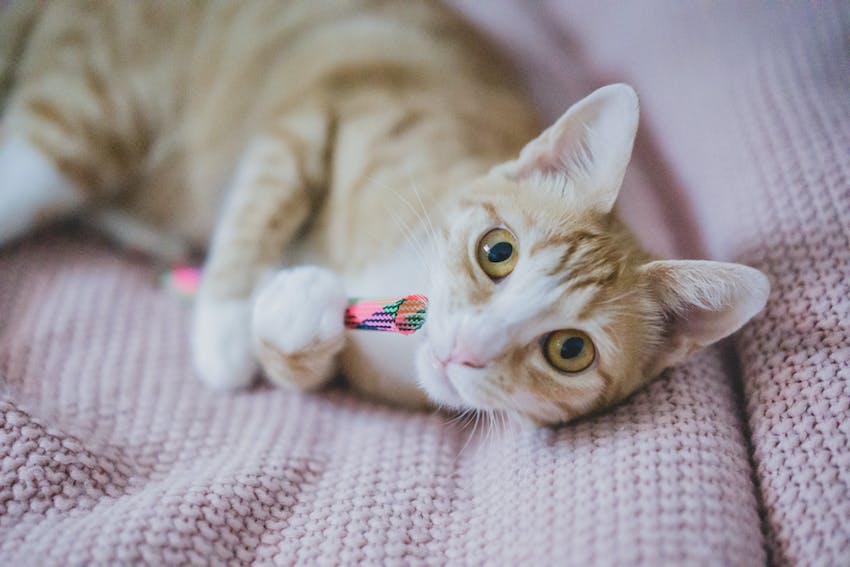Lifespan
15 to 17 years
By : Trupanion Staff | Updated May 28, 2024
Lifespan
15 to 17 years
Weight
10 - 22 pounds
Energy level
Mellow fellow
Playful prowler
Ninja Warrior

Domestic Shorthairs have unknown mixed breed origins. As a result, these kitties can be found in any color, color combination, or pattern that is seen in other cat breeds, from tabby to tuxedo to tortoiseshell, and beyond.
Most often, their coloring and look trend toward the most common coloring and body style of other pedigreed cats in their geographical area. For example, Domestic Shorthair cats in Asia quite often have Siamese coloring, while Domestic Shorthairs in the United States and the United Kingdom tend to have a larger, sturdier body and long, athletic legs.
Domestic Short Hair cats vary in temperament and personality, depending on their genetics and learning experiences. You’ll find all “types” of these mixed breeds, which means there’s some kitty for everyone! In fact, they’re often the first cat for many owners, due to their prevalence in shelters and rescues.
When choosing a Domestic kitten or adult cat, make sure to look for a companion that fits in with your lifestyle.
Domestic Short Hairs have varied lifestyle preferences. Some are content to lounge around with their human guardians with occasional short play sessions, some are independent and self-entertaining, and others are highly active, intelligent, and require constant physical and mental stimulation.
If you have a particular lifestyle you’d like to share with your furry friend, consider adopting an adult cat. Since they’ve already grown into their personalities, you can get a better sense of the lifestyle they’ll need.
Kittens (as a general guideline) tend to be active and playful but may mellow out or maintain their energy level as they get older. You never know what you’re going to end up with when you bring home a kitten! That’s part of the fun.
Domestic Short Hair cats can be found all over the world, as they are simply cats of a long and mixed heritage, with short fur. Throughout history, they’ve acted as workers and companions to their families. Arriving in America aboard the ships of the early settlers, including the Mayflower, these cats played an important role in the new world. They may have started out keeping rodents at bay for pioneers and shopkeepers but soon became a popular family pet. According to data from the American Veterinary Medical Association, 25% of American households include a cat. The Domestic Short Hair will no doubt continue to play a big role in cat culture.

Depending on your cat’s personality, they may get along well (or not) with other kittens, adult cats, household pets, and people. It’s always best to introduce your cat to a potential new friend slowly, giving them a choice whether to interact, and providing positive reinforcement for positive interactions.
Take extra care in introducing cats to each other, as most cats require time to get to know a new feline companion. Introductions that are rushed can result in fighting or injuries, undesirable behaviors (such as house-soiling), and stress for both humans and animals.
The Domestic Short Hair cat needs enough exercise to stay healthy and trim, as well as preventing unwanted behavior problems. Provide them with sufficient playtime, areas to climb, and encourage them to follow you around the house (or leash train them for outside walks) to get their steps in every day.
All cats require mental enrichment to keep their minds sharp and active. Boredom can cause stress, which results in behavior issues. To keep your kitten or adult cat from getting bored, make sure you provide them with plenty of toys, rotated regularly, to keep them novel and exciting; plenty of perching places to climb and explore; cozy nooks in which to take naps; windows from which to watch wildlife; play (using an interactive wand toy) providing an outlet for their instinctive predatory behaviors; and puzzle-solving opportunities (such as food puzzles). Depending on how inquisitive, motivated, and intelligent your cat is, you might also consider clicker-training tricks and commands.
While many Domestic Short Hair cats don’t exhibit behavior issues, they can crop up if cat guardians aren’t meeting the needs of their cat. Most common are house-soiling (especially if appropriate litter box setups are not provided and maintained); inter-cat aggression (if a slow-introduction process is not followed); and destructive behavior such as scratching furniture, knocking over objects, and counter-surfing (particularly if ways to alleviate boredom are not provided).
The potential for encountering these problems can be minimized or avoided by making sure your cats’ needs are being met. This means an appropriately clean place for elimination, territorial security, mental and physical exercise, and social interaction.
Cats are also known to exhibit behavioral issues or changes if they’re experiencing pain, discomfort, or medical problems. So it’s important to manage your kitty’s health with regular visits to the veterinarian.
Veterinarian tip
Never leave your cat alone near an open window that doesn't have a secure screen. If it's on the first floor, your cat can get out of the house and get injured, lost or any of the other possible problems that outdoor cats face on a daily basis. If the window is on the second floor or above your cat is at risk of suffering from severe injuries of "high-rise syndrome," and you don't even need to live in a true high-rise building. The injuries of "high-rise syndrome" tend to be worst in falls from between the 2nd and 7th floors!
Thick, double coat of fur shorter than 1-inch long
All Domestic cats need regular maintenance to keep their coats healthy. Shorthairs need weekly brushing (more during seasonal shedding periods). This helps prevent matting and furballs.
While most are quite capable of keeping themselves clean, sometimes a bath is in order. Like all cats, the Domestic Short Hair cat requires regular nail trimming and teeth brushing to stay happy and healthy.